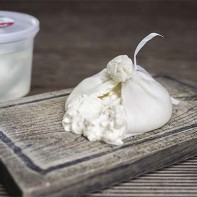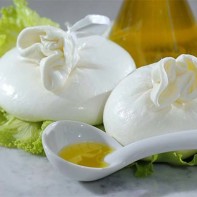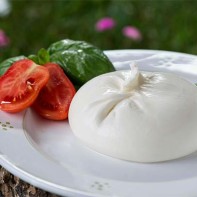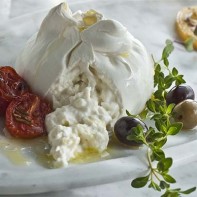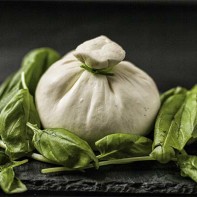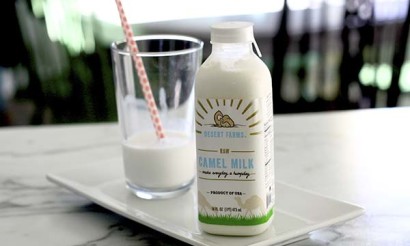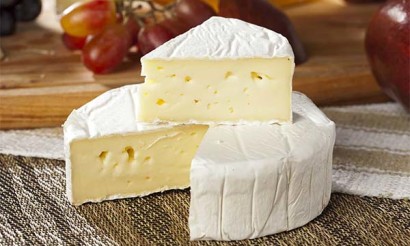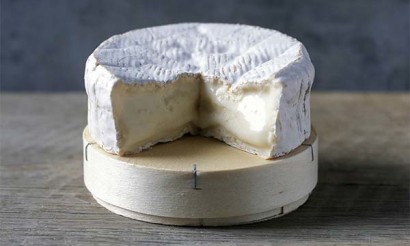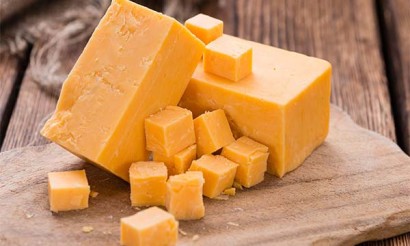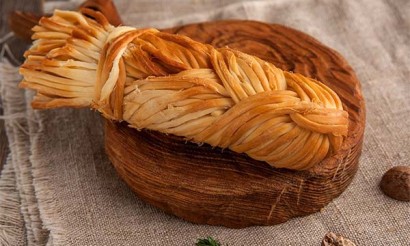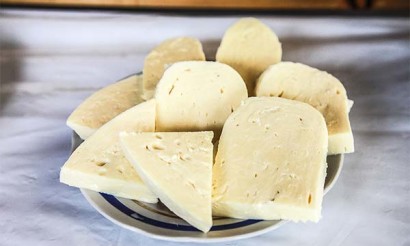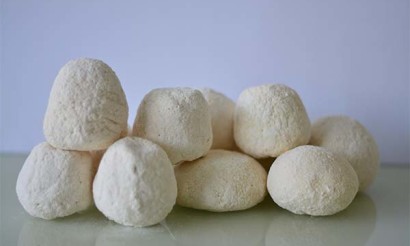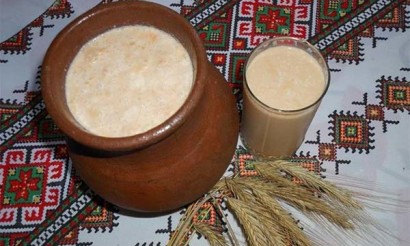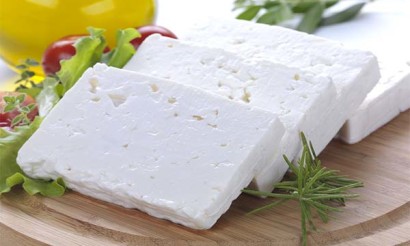Burrata cheese: what it is, how to eat it, useful properties
Delicate burrata cheese has become popular in a short time due to its bright creamy taste, creamy consistency, and unusual presentation. The snow-white pouch with a soft filling is quite caloric, contains a lot of calcium, selenium, phosphorus, vitamins D, B2, B12, A, Omega-3, 6, 9 fatty acids.
- Burrata cheese: what it is, what it's made of, and what it tastes like
- History of origin
- What is made of.
- What does it taste like?
- How burrata differs from mozzarella and strachatella
- Composition and Calories
- What is burrata cheese good for?
- Can cheese be given to pregnant and lactating women?
- Harm and contraindications
- How to Choose and Store
- Where to Buy and How Much Does It Cost?
- How and with what to eat burrata
- What can be eaten with?
- Do you eat burrata pouch?
- What Wine to match the Cheese
- How to make burrata cheese at home
- What can be made from burrata: recipes
- Salad
- Pasta
- Focaccia
- Pizza
- What can be substituted in the recipes
Burrata: what is it, how is it made and what does it taste like?
Burrata, originally from Italy, is a delicate variety of mozzarella with its own history, different structure inside and outside. There is a reason for the name of the cheese. The Italian word burro translates as butter. In the proportion of dry matter of the dairy product, the fat is 40-60%.
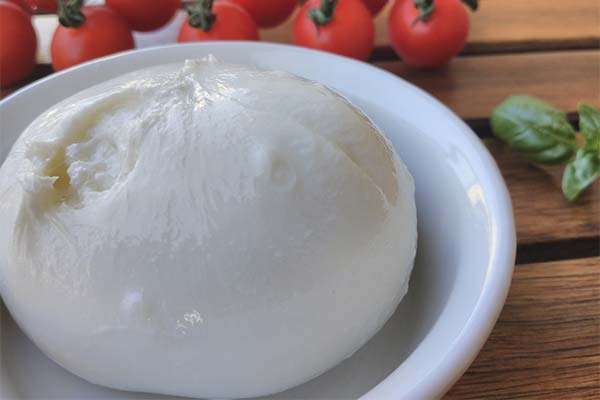
Cheese is similar to mozzarella only externally. If you pierce the shell, assembled in the form of a pouch, under it is a semi-liquid mass of cheese. To emphasize the delicate flavor, manufacturers wrap the product in leaves of carnelian or other aromatic plants.
History of origin
The idea of creating a recipe for young cheese came from the accumulation of residues of the production of cream, mozzarella at the farm "Bianchini". For 30 years the product was enjoyed only by the locals of Andria and its surroundings, located in the southern Italian region of Puglia.
Only in the 50s of the last century the cheese, presented to consumers as a premium product, became known to all Italians, and a few years later it entered the European market. Now the delicacy product is made by hand in the cheese dairies of Basilicata, Puglia and Campania regions.
What is it made of?
Exquisite Italian cheese is made from cow milk, buffalo milk, and heavy cream.
At the initial stage of preparation the milk is fermented using rennet. Then, for elasticity, the cheese clot is dipped into salted hot water, pulled out of it in flaps, and given the desired shape.
The hot cheese balls are used to make sacks, inside which a mixture of cream, strachatella is placed. The top of the sack is pulled into a bundle and tied with a knot.
What it tastes like.
Consumers describe the taste of burrata with liquid filling as exquisite, sweet and salty, creamy, very tender and soft.
If bitterness or sour taste is felt, it means that the shelf life has expired or the cheese was stored in unsuitable conditions.
How burrata differs from mozzarella and strachatella
All three products belong to the same group of young Italian cheeses.
Mozzarella with its delicate, milky, creamy flavor is produced in the form of balls of varying diameters. The cheese has a glossy sheen on the outside and a porous texture on the inside, which gives off a milky whey when pressed. The product is sold in brine, used to make vegetable casseroles, pizzas, and pasta sauces.
Strachatella is made from leftover mozzarella by pulling porous strands from the cheese dough. The strands are poured with cream for several hours to improve flavor.
Soft cheese is sometimes added to pasta or soups. More often it is served as a separate dish with tomatoes, greens, pepper, balsamic vinegar. Less commonly, strachatella is eaten with berries, figs, caramelized pears, and apples.
Burrata is a product that includes mozzarella, strachatella and cream. In the production of the cheese, a ball of mozzarella is rolled into a flatbread from which a pouch is made. Inside the bag put strachatella and cream, the ends of the bag pulled, tied a knot or tied with string, plastic tape, leaves of plants.
Composition and calories
Burrata cheese contains significant amounts of protein, cobalamin, vitamin A, riboflavin, calcium, phosphorus, selenium, zinc. The product contains saturated and unsaturated Omega-3, 6, 9 fatty acids.
The content in 100 g of cheese vitamins, minerals:
Vitamins:
- Cobalamin - 0.002 mg.
- A - 0,2
- Riboflavin - 0,3 mg.
- Calciferol - 0.001 mg.
- Choline - 15.4 mg.
- Pantothenic acid - 0.1 mg.
- Thiamine - 0.03 mg.
- Pyridoxine - 0.04 mg.
- Phylloquinone - 0.002 mg.
- Folate - 0.007 mg.
- Tocopherol - 0.2 mg.
- Beta carotene - 0.06 mg.
- PP - 0.1 mg.
Micronutrients:
- Selenium - 0.02 mg.
- Zinc - 2.9 mg.
- Iron - 0.4 mg.
- Manganese - 0.03 mg.
- Copper - 0.01 mg.
Macronutrients:
- Calcium - 505 mg.
- Phosphorus - 354 mg.
- Sodium - 486 mg.
- Sulfur - 222 mg.
- Magnesium - 20 mg.
- Potassium - 76 mg.
GI of 100 grams of burrata - 17, 20, 2 g, respectively. Energy value - 255 kcal.
What is burrata cheese good for?
Cheese saturates the body with easily digestible protein, which is used to regenerate damaged cells and grow new ones. The amino acids in the product are involved in the production of neurotransmitters, enzymes, and hormones.

Burrata cheese in section
Other health benefits of burrata:
- Supports eye, skin, mucosal, and reproductive health.
- Resists disorders of color perception, blood clotting, development of anemia.
- Participates in hematopoiesis.
- Regulates muscle contractions, the central nervous system.
- Prevents rickets, osteoporosis, tooth decay, and mineralizes bone tissue and enamel.
- Regulates energy metabolism, acid-base balance.
- Improves immune response, increases the body's resistance to cold-related infections.
Selenium in the burrata protects the health of blood vessels, heart, supports the function of the thyroid gland, participating in the regulation of thyroid hormones. The trace element heals tissues, improves hair, nails, skin, slows aging, and normalizes pancreatic function.
Selenium in 100 g of the product exceeds the daily requirement of the body by 30%.
Sodium in burrata supports muscular corset, elasticity of tissues, regulates water-salt metabolism, blood pressure.
Calcium is needed not only to strengthen bones. The mineral improves blood flow, reduces the production of low-density lipids.
Can cheese be given to pregnant and lactating women
The product, which is rich in proteins, vitamins, calcium, phosphorus, selenium and Omega-3, can include pregnant and nursing women in their diet. The components of cheese ensure the development of the fetus without abnormalities, make up for the deficiency of vitamins and minerals.
Burrata is useful for anemia, hormonal imbalance, poor appetite, unstable psycho-emotional states.
You should not buy it from private dealers, as there is a high risk of contracting listeriosis. Listeria monocytogenes bacteria affect the lymphatic system, inhibit fetal development, lead to miscarriage or late-term premature birth.
Harms and contraindications
Contraindications to the use of burrata:
- Dairy protein intolerance;
- lack of enzymes to break down lactose;
- digestive disorders;
- Exacerbation of pancreatitis, gastritis, peptic ulcer, bowel.
The harm caused by cheese in excess of the norm (60 g per day). Burrata with a share of fat 40-60% increases the risk of cholesterol plaques, diseases of the cardiovascular system.
In addition, the product contains tryptophan, which in high doses causes sleep disorders and headaches. You should give preference to lean brine cheeses for obesity, the desire to lose extra pounds.
How to choose and store
To buy the original product and not the mascarpone in mozzarella balls, visit specialty cheese stores or large supermarkets. When choosing a product pay attention to the integrity of the packaging, shelf life and price. It should be one-third the price of mozzarella.
In unopened packaging in the refrigerator, the cheese retains its consumer properties until the expiration date specified by the manufacturer (7-10 days). The remainder of the product is transferred into a food container along with the preservative liquid, stored for up to four days. Cheesemakers recommend eating soft cheese on the first day of purchase. Gourmets believe that the taste reveals most fully on the second, third day.
Where to buy and how much costs
In Russian grocery stores Italian cheese is difficult to find. But it offers private cheese shops and many selling online sites at a price of 1800-2000 p. per 1 kg. The high price of the product is due to its scarcity on the market.
In Italy, 1 kg of burrata can be bought for 15-18 euros. In the eastern United States, where many Americans of Italian descent live, the popular product is sold for $20-24.
How and with what to eat burrata
An hour before eating, the cheese is taken out of the refrigerator so that it warms to room temperature, acquiring the right structure. Before serving burrata salted, peppered and drizzled with olive oil.
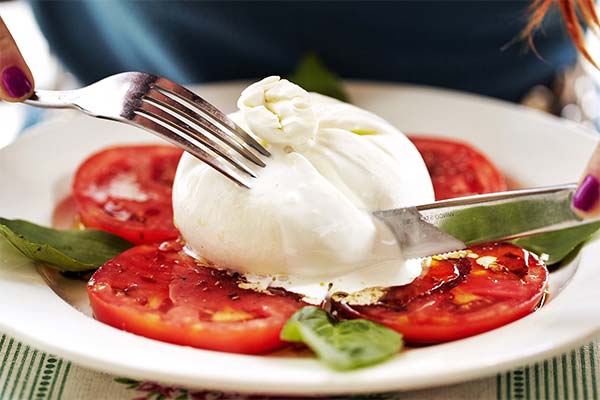
To fully experience all the flavors, the cheese is eaten as a separate dish with bread, toast.
It is desirable to eat the product in the first 48 hours. Older burrata is quite edible, but it has the smell of sour milk.
What to combine it with
To the cheese plate is added:
- garlic;
- honey;
- balsamic vinegar;
- pesto sauce;
- nuts;
- melon;
- beet;
- legumes;
- lemon;
- tomatoes;
- arugula;
- shallot;
- avocado;
- celery, basil, mint;
- olives.
You don't want to eat a lot of different foods with cheese at once. You can make an appetizer in the colors of the Italian flag (caprese), adding tomato slices and basil leaves to the burrata, drizzled with olive oil and balsamic vinegar. Another unusual original variant of serving is with strawberries, mint, and balsamic sauce.
Do you eat the buratta sack?
Just before eating, small pieces of buratta sack are cut from the top, drizzled with vegetable oil, and eaten. The liquid filling is collected with bread.
What wine goes with cheese
Italian sparkling wine, champagne, red semi-dry from Sangiovese grapes or buttery chardonnay, soave with a creamy texture, notes of cream, is suitable for a dairy product with a rich creamy flavor.
How to make burrata cheese at home
Burrata, which has appeared on the shelves of Russian stores, tastes inferior to the real Italian product. To be sure of this, you can make the cheese at home and compare it with a purchased one.
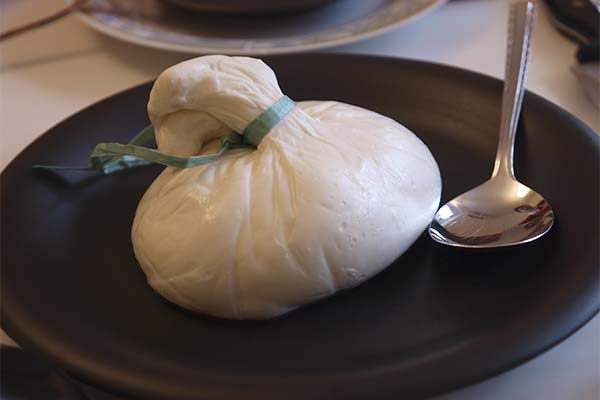
Ingredients:
- 12 liters of milk with a fat content of 3.5%;
- 50 ml of 33% cream;
- 3g of rennet;
- thermophilic sourdough starter;
- salt;
- 3 tsp. citric acid.
From the kitchen utensils you will need large pots for milk, cold water and other things, litmus strips, and a thermometer.
How to prepare:
- Dissolve citric acid in 150 ml boiled water, and rennet in 50 ml.
- Remove the milk from the refrigerator, check the acidity with litmus. If the pH is below 6.1-6.2, pour in the citric acid solution.
- Slowly heat the milk on the stove to 37°C. Add the thermophilic starter and stir. Add the water and rennet and stir once more. Allow the product to curdle for 40 minutes.
- Cut the resulting clot into 5 cm by 5 cm cubes.
- After 10 minutes, heat the cheese mixture to 42 degrees, dice to the size of walnuts, return to the pan. Heat again to the desired temperature, stirring constantly.
- Turn off the stove when the cheese slices sink to the bottom.
- Drain part of the whey, leaving a volume that covers the clots by 3 cm.
- The next step is to prepare the filling. Remove a third of the clots from the pan. In another container bring to a boil, but do not boil 2 liters of water with 1 tbsp of salt.
- Pour the hot water over the cheese slices set aside for the filling. When they have softened, roll them into one ball. Pull the shreds out of the ball, then mold into one kolob again.
- Put the cheese dough in a saucepan with water. As the liquid cools, add hot liquid to keep the clump pliable.
- Repeat the procedure one more time. For the third time, pull a ribbon out of the clod, drop it into cold water.
- After curing, cut the ribbon into 20-centimeter sections, each of which you divide into thin fibers with your hands.
- Fill the strachatella with cold cream.
- Make pouches from the remaining clots. Fill them with 80°C salted water, stretch them one by one and roll them into balls up to six times.
- Flatten each smooth ball into a cake with your fingers. Form sacks with 2-3 mm thick walls and a thicker bottom.
- Fill the cheese molds with the filling. Roll up the edges, tie with string. Dip in cold water.
You can do without string if you heat the edges with hot water, pull them into a bundle and tie with a knot.
What you can make with burrata: recipes
Pieces of cheese are included in recipes for vegetable and sweet salads, pasta, casseroles, pizza, lasagna, open pies, lentils. It is important to add burrata to hot dishes at the end of cooking to preserve the creamy texture of the filling.
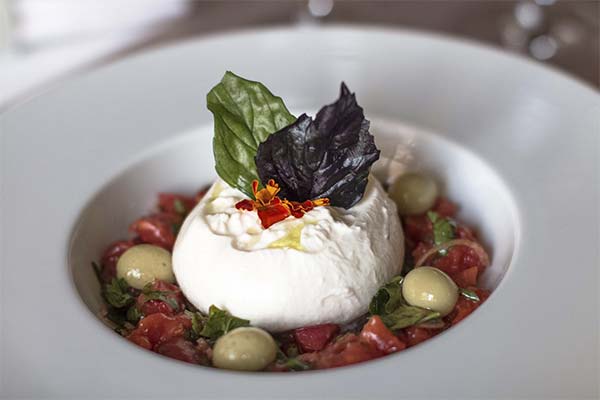
Salad
To make a spicy, tangy chili salad, prepare a set of products:
- 200 g burrata;
- A handful each of capers, seedless olives;
- A broccoli broccoli;
- quarter of a sweet red bell pepper;
- 2 cloves of garlic;
- 30 ml of lemon juice;
- Half a pod of red and green chilies;
- 50 ml of olive oil;
- salt.
How to prepare:
- Separate broccoli into florets. Put in boiling water, simmer for 2 minutes, then drain in a colander.
- Chop the chili, removing the seeds. Dice bell peppers.
- Peel garlic and slice.
- Saute bell peppers and garlic in olive oil. Drizzle with lemon juice.
- Halve olives and cut cheese into small pieces.
- Arrange the hot cabbage florets, olives, capers and cheese in a dish. Season with salt.
- Place the peppers, garlic, pour the oil in which they were fried.
The final touch to the warm salad is arugula leaves, torn with your hands.
Pasta
To make pasta with vegetables and cheese you will need:
- 200 g of pasta;
- lemon;
- a small size zucchini;
- 100 g of frozen green peas;
- 50 g each of green beans, pine nuts;
- bunch of basil;
- 60 g of burrata cheese;
- 80 ml olive oil;
- 1 tsp. salt;
- 0.5 tsp. sugar.
Preparation steps:
- Defrost the peas.
- Slice zucchini into strips with a vegetable peeler. Fry in 1 tbsp vegetable oil.
- Boil peas, beans.
- Boil pasta. Rinse in a colander.
- Grate lemon zest. Juice half of the fruit.
- Place in blender, beat nuts, zest, salt, sugar, 3 spoons of oil, lemon juice.
- Place zucchini, peas and beans in a bowl with prepared pasta. Season with sauce and stir together.
- Break cheese into slices and place on top.
The basil sauce can also be used to dress salads.
Focaccia
The base of the dish is pizza dough.
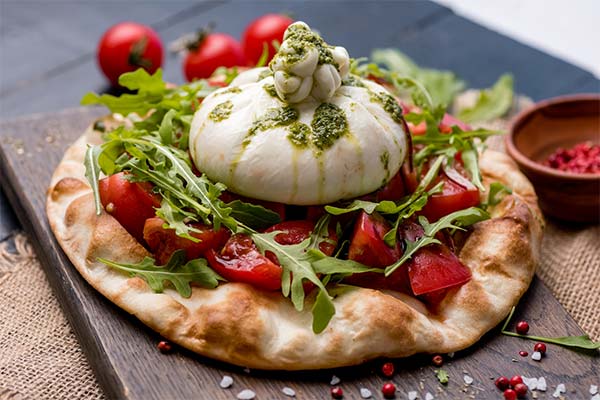
Product set:
- 200 g of wheat flour;
- 1 tsp. dry yeast;
- 1 tsp. salt, sugar;
- 2 tbsp. canned tomatoes in their own juice;
- 2 Tbsp. olive oil;
- Two fresh tomatoes;
- dried basil;
- 2 pcs. burrata;
- green onions.
Method of preparation:
- In 100 ml of water, dissolve the yeast, add sugar.
- After 15 minutes, combine the flour with salt. Pour in dissolved yeast, oil.
- Knead dough for 10 minutes. Cover with a towel and put in a warm place.
- After half an hour, place the dough on a cutting board or a table sprinkled with flour. Form two tortillas with your hands.
- Whisk the canned tomatoes with a blender. Brush each patty with the tomato mixture. Sprinkle with basil.
- Bake the wheat tortillas in an oven preheated to maximum temperature for 8 minutes.
- Chop the onion feathers and slice the fresh tomatoes into large slices. Place the onions and tomatoes on the prepared tortillas. Place burrata on top.
Serve the dish sliced into portions as an appetizer.
Pizza
The taste of the pizza with creamy burrata is memorable for a long time. The gastronomic pleasure wants to repeat as often as possible.
Ingredients:
- A portion of dough for one pizza;
- 50 g of mozzarella;
- One standard bag of burrata;
- 3 strips of jamon, ham;
- handful of arugula, basil leaves;
- 0.4 kg ripe tomatoes;
- cornmeal;
- olive oil;
- salt, pepper.
Step-by-step cooking instructions:
- Form a circle from the dough. Spread out on a baking tray dusted with flour.
- Grate mozzarella, then tomatoes, removing skins. Rinse the tomato mixture in a sieve to drain off the liquid.
- Place shredded tomatoes on the dough, season with salt. Sprinkle with cheese.
- Bake the pizzas in the oven for 10 minutes at 200°C and another 5 minutes at 240°C.
- Remove the pizza from the oven, top with the burrata cut into 6 equal pieces.
- Return the pizza to the oven for 2 minutes.
Before serving, place the ham and basil between the cheese slices. Place arugula in the center, drizzle with oil, and cut into portions.
What can be substituted in recipes
There is no complete substitute, but you can melt mozzarella instead of burrata on pizza, in pasta or vegetable casseroles. In this case, there will be no contrast between the outer and inner texture, but the taste will be similar.
The delicacy product is able to give gastronomic delight, to support the health of the spine, joints, to establish the metabolism. But do not forget about the high caloric content of the product and a limited shelf life.
«Important: All information on this site is provided solely for introductory for educational purposes. Before applying any recommendations, you should consult with a specialized specialist. Neither the editors nor the authors shall be liable for any possible harm caused by materials."

